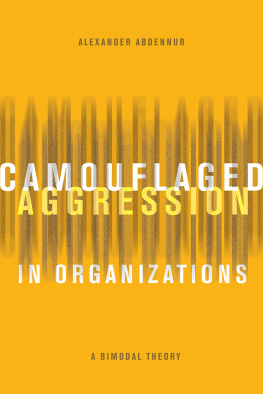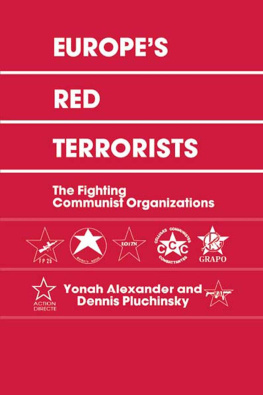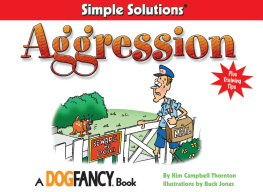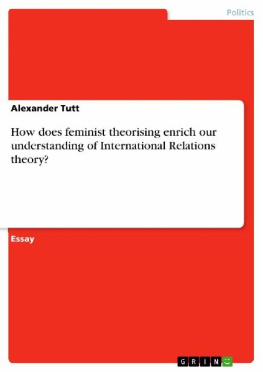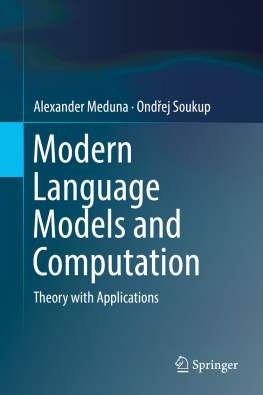Alexander Abdennur - Camouflaged Aggression in Organizations: A Bimodal Theory
Here you can read online Alexander Abdennur - Camouflaged Aggression in Organizations: A Bimodal Theory full text of the book (entire story) in english for free. Download pdf and epub, get meaning, cover and reviews about this ebook. year: 2020, publisher: University of Alberta, genre: Romance novel. Description of the work, (preface) as well as reviews are available. Best literature library LitArk.com created for fans of good reading and offers a wide selection of genres:
Romance novel
Science fiction
Adventure
Detective
Science
History
Home and family
Prose
Art
Politics
Computer
Non-fiction
Religion
Business
Children
Humor
Choose a favorite category and find really read worthwhile books. Enjoy immersion in the world of imagination, feel the emotions of the characters or learn something new for yourself, make an fascinating discovery.
- Book:Camouflaged Aggression in Organizations: A Bimodal Theory
- Author:
- Publisher:University of Alberta
- Genre:
- Year:2020
- Rating:4 / 5
- Favourites:Add to favourites
- Your mark:
- 80
- 1
- 2
- 3
- 4
- 5
Camouflaged Aggression in Organizations: A Bimodal Theory: summary, description and annotation
We offer to read an annotation, description, summary or preface (depends on what the author of the book "Camouflaged Aggression in Organizations: A Bimodal Theory" wrote himself). If you haven't found the necessary information about the book — write in the comments, we will try to find it.
Camouflaged Aggression in Organizations: A Bimodal Theory — read online for free the complete book (whole text) full work
Below is the text of the book, divided by pages. System saving the place of the last page read, allows you to conveniently read the book "Camouflaged Aggression in Organizations: A Bimodal Theory" online for free, without having to search again every time where you left off. Put a bookmark, and you can go to the page where you finished reading at any time.
Font size:
Interval:
Bookmark:
Published by
University of Alberta Press
1-16 Rutherford Library South
11204 89 Avenue NW
Edmonton, Alberta, Canada T 6 G 2 J 4
uap.ualberta.ca
Copyright 2020 Alexander Abdennur
LIBRARY AND ARCHIVES CANADA
CATALOGUING IN PUBLICATION
Title: Camouflaged aggression in organizations : a bimodal theory / Alexander Abdennur.
Names: Abdennur, Alexander, 1945 author.
Description: Includes bibliographical references and index.
Identifiers: Canadiana (print) 20200249037 | Canadiana (ebook) 20200249150 |
ISBN 9781772124910 (softcover) |
ISBN 9781772125290 ( EPUB ) |
ISBN 9781772125306 (Kindle) |
ISBN 9781772125313 ( PDF )
Subjects: LCSH : Violence in the workplace. | LCSH : Personnel management.
Classification: LCC HF 5549.5. E 43 A 23 2020 | DDC 658.4/73dc23
First edition, rst printing, 2020.
First electronic edition, 2020.
Digital conversion by Transforma Pvt Ltd.
Copyediting by Anne Laughlin.
Proofreading by Joanne Muzak and
Tanvi Mohile.
Indexing by Adrian Mather.
Cover design by Alan Brownoff.
All rights reserved. No part of this publication may be reproduced, stored in a retrieval system, or transmitted in any form or by any means (electronic, mechanical, photocopying, recording, or otherwise) without prior written consent. Contact University of Alberta Press for further details.
University of Alberta Press supports copyright. Copyright fuels creativity, encourages diverse voices, promotes free speech, and creates a vibrant culture. Thank you for buying an authorized edition of this book and for complying with the copyright laws by not reproducing, scanning, or distributing any part of it in any form without permission. You are supporting writers and allowing University of Alberta Press to continue to publish books for every reader.
University of Alberta Press gratefully acknowledges the support received for its publishing program from the Government of Canada, the Canada Council for the Arts, and the Government of Alberta through the Alberta Media Fund.

CONTENTS
INTRODUCTION
THE PURPOSE OF THIS BOOK is to identify common forms and strategies of aggression that are today permeating the workplace and social interaction in general. The expressions of aggression studied here are often carried out in the context of large, complex organizational structures where organizational procedures and regulations can be used as instruments for the delivery of and as masks for the aggression. In this book, aggression is defined as any action or inaction directed by an individual toward the goal of making another individual suffer.
The bimodal theory of aggression proposed in this book maintains that when aggression is expressed through formal structures it becomes masked. Four components of the aggressive act can be hidden: the intention to hurt, the perpetrator, the act of aggression, and even the victim. The structures of the formal organization can mask and rationalize all of the above components, while none of them can be masked within a strictly interpersonal conflict. Thus, in the context of formal organizations, the psychological drive of aggression undergoes three qualitative changes: 1) it acquires multiple avenues for expression; 2) it seeks to avoid responsibility or retaliation; and 3) it undergoes a phylogenetically based regression. This regression shares aspects of the camouflage strategy relied on in lower species. The animal uses camouflage (as blending and false pretence) to better zero in on the prey, to escape being preyed on, and to minimize counterattack. The use of camouflage and deception may at certain times be viable in a competitive world; yet it is important to note that humans evolved mainly through directly confronting the world and transforming the environment.
According to the proposed bimodal theory, aggression is expressed through two major modes: the confrontational mode and the non-confrontational mode. These two modes, which emerge from the same drive, become qualitatively differentiated in their social expression and impact. Being qualitatively different, a dialectical relationship develops between them, allowing them to balance and contain each other. Since most types of aggression in organizations are expressed through formal structures, they are often non-confrontational and masked. When avenues for expression and redress belonging to each mode are available, camouflaged aggression is better contained, as this allows the processes of modal balancing to take place. When avenues for the expression of one mode are not available, there is an increase in the aggression in the opposite mode, which is often followed by an increase in the overall level of aggression.
There has been rising public concern about non-violent aggression in the workplace. This type of aggression can negatively impact morale, mental health, and productivity. Four main approaches to workplace aggression have been adopted by experts studying this phenomenon:
A personality approach, focused on typical personality traits of perpetrators as they behave in organizational settings. Some experts (e.g., Markham, 1993) describe typical cases of difficult individuals in the workplace and how to handle them. Others (e.g., Babiak & Hare, 2006) use case illustrations based on the established psychiatric diagnosis in their study of the workplace psychopath. The present study examines the several personality disorders in relation to workplace aggression. Established diagnoses may constitute better reference points than general case studies.
A management approach, which relates most aggressive behaviour in the workplace to failures in management. Instances of inadequate management create frustrations and conflicts that lead to all forms of aggressive behaviour. Effective organizational behaviour reduces aggression.
A classification approach, which focuses on categories of abusive behaviour in the workplace. This approach seeks to account for workplace aggression by depicting: 1) the type of aggressive behaviour, 2) the type of harm inflicted, 3) the motive behind the behaviour, and 4) the medium or context of expression, such as physical, verbal, emotional, sexual, and cyber forms of aggression. Such accounts appear under classifications and general constructs such as bullying, mobbing, incivility, abusive supervision, social undermining, work sabotage, and interpersonal conflict. The most popular construct has been bullying . The term has been extensively used to refer to forms of behaviour intended to harass, intimidate, dominate, manipulate, and humiliate a person, in the workplace and other social domains (Williams, 2011; Lipinski & Crothers, 2014; DeLara, 2016). When bullying is carried out by a group against an individual, it is referred to as mobbing (Leymann, 1996; Duffy & Sperry, 2014). An essential assumption for the existence of bullying is an imbalance of physical and social power;
the stronger party bullies the weaker. But in complex formal systems the behaviours described as bullying can be carried out without a power differential; they can be carried out horizontally and upwardly through the organizational structure. Accordingly, bullying becomes less distinguishable from conflict where indi-viduals clash over opposing principles, interests, and perceptions. But most importantly, it tends to overlap with other related
behaviours, such as abusive supervision, social undermining, and incivility (Hershcovis, 2011). Paradoxically, the construct of bullying is largely incongruent with the symbol it is attached to. The bull attacks in a straight line and is highly visible, whereas organizational bullying is often indirect and camouflaged.
Font size:
Interval:
Bookmark:
Similar books «Camouflaged Aggression in Organizations: A Bimodal Theory»
Look at similar books to Camouflaged Aggression in Organizations: A Bimodal Theory. We have selected literature similar in name and meaning in the hope of providing readers with more options to find new, interesting, not yet read works.
Discussion, reviews of the book Camouflaged Aggression in Organizations: A Bimodal Theory and just readers' own opinions. Leave your comments, write what you think about the work, its meaning or the main characters. Specify what exactly you liked and what you didn't like, and why you think so.

